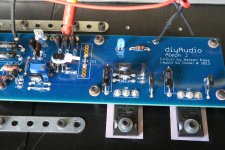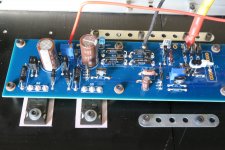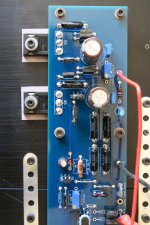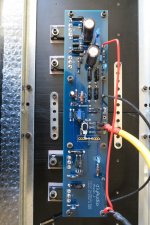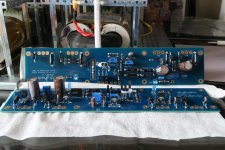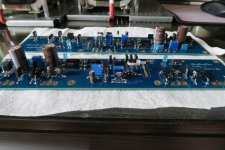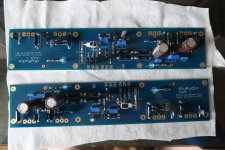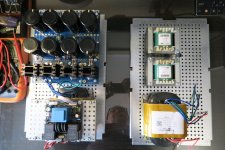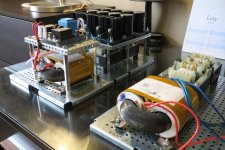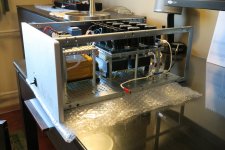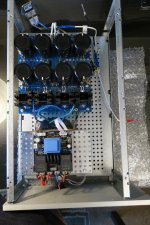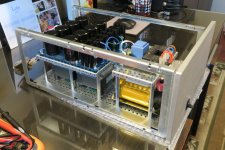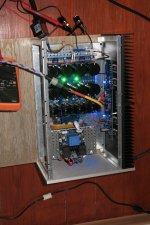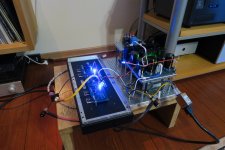As long as there are no safety concerns, I'm happy just listening. 


I appreciate everyone's input.



I appreciate everyone's input.
@Vunce - certainly
that info - edit - was after my reply ..... or I would comment
0R showing that somewhere is unplanned connection between Audio GNS and chassis ....... which can be a problem, representing a loop
that info - edit - was after my reply ..... or I would comment
0R showing that somewhere is unplanned connection between Audio GNS and chassis ....... which can be a problem, representing a loop
I was wondering that myself as I typed.Shouldn't the ohmic value of the NTC be the DMM reading measuring signal gnd to chassis?
Hmmm, are you using the diyaudio store PSU boards? I thought the mounting eyelets are not connected to the ground plane on those. I might be wrong of course as I am lazy to open my amp and check!🙄
PSU board can be made with intention to be connected to chassis through standoffs, and can be made intentionally not to have connection with chassis through standoffs
which arrangement is going to be used, well, that's planning
I know that some of Pa's PSU pcbs are made in one way, other are made in second
though, me still lacking lifetime or two to reach Papa's level (of whatever), I'm still Chicken so all mounting holes on my pcbs being well isolated from anything else on pcb
(I'm cheating, just realized that I have two thingie pcbs having deliberate contact with chassis ..... planned )
)
which arrangement is going to be used, well, that's planning
I know that some of Pa's PSU pcbs are made in one way, other are made in second
though, me still lacking lifetime or two to reach Papa's level (of whatever), I'm still Chicken so all mounting holes on my pcbs being well isolated from anything else on pcb
(I'm cheating, just realized that I have two thingie pcbs having deliberate contact with chassis ..... planned
 )
)No, I'm using the BrianGT "Mini-Aleph" PSU and amp boards.Hmmm, are you using the diyaudio store PSU boards? I thought the mounting eyelets are not connected to the ground plane on those. I might be wrong of course as I am lazy to open my amp and check!🙄
As I hauled the amp back to the bench, I doubted that the diyAudio board was designed that way.
But there is more fun yet to be had - I've come full circle and bias and offset have a mind of their own again. I'm about to throw this heap in the lake.
Have a look at the attached photo... see which way works better for you. Leave a piece of wire hanging... and then try:
a) feeding the shield wire to the PCB GND (in my case this worked better - I liked it better sound-wise)
or
b) terminate the interconnect shield straight to the chassis (still okay, and according to Rene - the correct way to do things...) - and do not feed it to the PCB GND
I did not have any hiss or buzz when I tried either a) and/or b)... nothing - like the amp is not ON at all.

a) feeding the shield wire to the PCB GND (in my case this worked better - I liked it better sound-wise)
or
b) terminate the interconnect shield straight to the chassis (still okay, and according to Rene - the correct way to do things...) - and do not feed it to the PCB GND
I did not have any hiss or buzz when I tried either a) and/or b)... nothing - like the amp is not ON at all.
No need to voltage torture more power out of the lovely Aleph J.
Just Build two amplifiers, and run them in twin parallel.
Added (besides the sonic upsides) Bonus: Dual mono always looks at least twice as nice.
🎷🥰🎸
Just Build two amplifiers, and run them in twin parallel.
Added (besides the sonic upsides) Bonus: Dual mono always looks at least twice as nice.
🎷🥰🎸
@Extreme_Boky
What does the job of inrush current limiting in that amplifier?
Edit:
And where are the rest of the wires...some type of Tesla power transfer?
What does the job of inrush current limiting in that amplifier?
Edit:
And where are the rest of the wires...some type of Tesla power transfer?
@Extreme_Boky
What does the job of inrush current limiting in that amplifier?
Edit:
And where are the rest of the wires...some type of Tesla power transfer?
The wires are very short and are soldered wherever possible. I do not use CL60 between PCB common, and chassis. Just short, multistrand wire...
The green arrow -> The mains (primary) wires, total length probably 2 inches.... tucked underneath the transformer mounting plate.
The red arrows -> The inrush current protection CL60. The CL60's legs are used and soldered directly to the IEC filter lug connectors.
White arrows -> The connection between PC PCB common and the chassis.
Black arrows -> The secondary wires, twisted and soldered from underneath of that PS PCB. Shortest possible length, tucked underneath the transformer metal plate (and sandwiched between the PS PCB and chassis).
Hello dear forum members. My name is Marek, I'm from Poland.
I just graduated from A.J. like everything worked out.
I have a problem with the shutdown: after about 2 seconds there is a short, not too loud, squeak in the speaker. What is the cause of this condition? Please help 🙂
I just graduated from A.J. like everything worked out.
I have a problem with the shutdown: after about 2 seconds there is a short, not too loud, squeak in the speaker. What is the cause of this condition? Please help 🙂
I bought the PCB of the amplifier, power supply and transistors in the DIYAUDIO STORE.
The whistle in the speakers 2 seconds after power off is still there. I corrected all soldering points - no result.
I measured the max voltage at the loudspeaker terminals during the whistle:
AC=1.8V, DC=0.0V.
The whistle in the speakers 2 seconds after power off is still there. I corrected all soldering points - no result.
I measured the max voltage at the loudspeaker terminals during the whistle:
AC=1.8V, DC=0.0V.
Attachments
Can a whistle voltage of around 2V RMS damage the speakers?
Sonically, the ear is happy 🙂
I build AJ as monoblocks in Modushop MonoBlock 4U 400 box. Attached photo with power supply.
Sonically, the ear is happy 🙂
I build AJ as monoblocks in Modushop MonoBlock 4U 400 box. Attached photo with power supply.
Attachments
- Home
- Amplifiers
- Pass Labs
- Aleph J illustrated build guide



